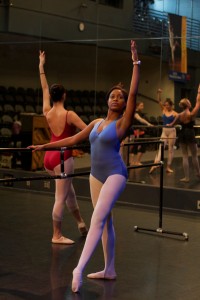“Mirror, Mirror on the Wall……..”
I’m happy to introduce you to our guest author, Sally Radell, a faculty member at Dance at Emory University in Atlanta, GA. Sally has been researching the use of mirrors in the dance classroom –how they can help us, and how they can hinder us. I first saw her present her work in this area in 2004, at the Taiwan International Dance Medicine Conference in Taipei. It is fascinating research, and well worth knowing about, both as a dancer and a teacher. Her article this month is geared towards what dancers need to know –coming in March: what teachers need to know, to promote the healthy use of mirrors in their students!
A personal note here — like most dancers, I grew up with mirrors in the studio, and never thought anything about it….it was a part of the dance world. But at American Dance Festival, in the 1980’s, I encountered Betty Jones, the world-famous Jose Limon dancer and teacher, who literally changed my dance life in many ways — including the use of mirrors in teaching. Betty was firmly against using them constantly — she had a small one in the studio, to use if necessary to point out something to a student. But her mantra was “Mirrors put you outside your body, not in it” –
knowing what I know now about the science of movement, and neurology, I completely understand what she meant.
I studied 10 years with Betty, and started integrating many of her classroom techniques into my own teaching, including the use (or not) of mirrors. I would make the dancers face away from the mirrors (we did not have drapes to cover them) for much of the class. It was fascinating to see the gradual change in their bodies, facial expressions, and movement.
Something to think about…..!
Aloha –
Jan__________________________________________________________

by Sally A. Radell, MFA, MA
When I reflect on my own time as a student training in dance I see myself staring at my image in the ever-present classroom mirrors. I recall a nagging voice in my head telling me that I was never thin enough, that I was not sufficiently strong, or that I was not as fluid as the other dancers. The mirror is indeed a potent tool in the dance classroom. Each dancer develops a personal relationship with the mirror, a relationship that is influenced by various factors including the technical level of the material taught, years of training, previous experiences in the art form, and comparison to others in the classroom. Often this relationship is combative, and it becomes a common part of a dance classroom culture.
Advantages of Mirror Use
There are positive reasons to use a mirror in dance training. The mirror provides dancers with immediate visual feedback and is helpful in self-correction. It allows them to evaluate the height, shape, and line of their movement, and to adjust their placement. It enables them to easily see the performance of the movement from several perspectives, which can help dancers learn a new movement phrase more quickly.
Disadvantages of Mirror Use
When dancers spend too much time looking at themselves in the mirror, however, they can become overly self-conscious and self-critical. This presents several problems in a dancer’s training.
- High levels of self-consciousness and self-criticism can cause a dancer to develop poor body image, which can lead a dancer to have negative thoughts and feelings about her body. This can easily happen when a dancer ends up comparing her physical image to other dancers or to the teacher in the room. Research has shown that negative body image in the dance classroom can slow down a student’s technical development.
- Spending too much time looking at oneself in the mirror can cause a dancer to focus excessively on her visual image rather than the muscular sensations of a movement. The sensation of one’s body in movement and the instinctive awareness of exactly where one’s body is in space is called proprioception, a critical ingredient for becoming a skilled and expressive dancer. Limited access to our proprioceptive self can slow down technical growth in the classroom.
- Overuse of the mirror can negatively affect the development of a dancer’s performance skills. Consistently staring at one’s body in the mirror can cause a dancer to be overly focused on body parts and specific positions rather than on movement and flow, which are essential qualities for a smooth and dynamic performance. After all, dancers in performance do not dance for the mirror, they dance for the audience. It makes sense they would practice this way.

- Remind yourself that the mirror is an optional tool in the technique class and train yourself to limit your use of it. Most dancers prefer to use the mirror in class and view it as an essential tool in the dance classroom. However, research has shown that if the mirror is not present in the dance classroom only about half of the students will miss it, and some students are actually relieved if it is not there.
- Focus on learning to trust the muscular feedback (proprioception) a movement provides; spend less time looking at your image in the mirror. This will accelerate your technical growth.
- Look for the full range of cues a teacher may give you when learning movement (i.e. imagery, rhythmic patterns). Work to expand all the ways you learn in technique class other than focusing on your image in the mirror.
- Observe yourself and note how you feel after using the mirror extensively in class. If you notice yourself having negative feelings about your body, this is a cue that you may need to further limit your use of the mirror in technique class.
- When you have the option, stand in a part of the room where mirror visibility is limited or choose a facing where you cannot see yourself in the mirror. Use the mirror strategically and selectively in class. Only use it when you have a specific purpose in mind.
- Set a goal of developing a personal, healthy relationship with the mirror, one that will fully support your own learning style. Listen to the cues your body gives you as you dance and act upon them. Take responsibility for creating your optimal learning environment in the dance classroom.
Sally Radell is professor of dance at Emory University in Atlanta, Georgia. She holds a BA in dance from Scripps College in Claremont, California, an MA in dance from The Ohio State University, and an MFA in dance from Arizona State University.
She came to Emory in 1987 to start a degree program in dance. The substantial growth of the program and success of this endeavor is one of her proudest professional accomplishments. Ms. Radell has been active as a choreographer, teacher, performer, administrator, dance critic, and somatic educator. Over the past twenty years she has conducted research on dancers, body image, and the mirror and has published in professional journals including Journal of Dance Medicine & Science, Research in Dance Education, and Perceptual and Motor Skills. Professor Radell has also presented nationally and internationally on this topic with different organizations including the International Association of Dance Medicine and Science. She is committed to the promotion of psychological wellness for dancers.





